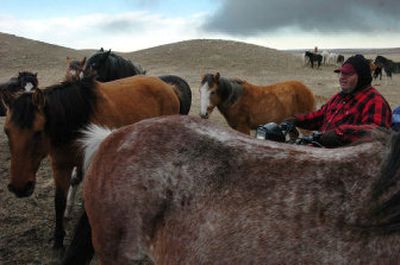Horse program passes on tradition to children

BROWNING, Mont. – On a ranch just outside of town, the sound of thundering hooves echoes across the prairie. Small herds of Spanish mustangs, with tails streaming behind them, gallop across the wind-swept plains.
In the summer, children also run across the prairie. They learn to care for the horses. They learn to ride. They learn about families by watching stallions interact with their herds.
It’s a safe, fun, adventurous atmosphere where children and horses thrive. And that’s the whole point of the Blackfeet Buffalo Horse Coalition, founder Bob Black Bull said.
“The main focus is the children and the horses, the horses and the children,” he said. “It’s like the yin and the yang. You can’t have one without the other.”
When he started the nonprofit organization more than a decade ago, Black Bull was told his desire to provide space for children to learn about and from the rare breed was a pipe dream. Today, however, more than 100 Spanish mustangs roam the 633-acre ranch, and scores of children flock there in the summer.
“All I can say is the creator is running the show, because I was told 12 years ago it wouldn’t make it,” he said.
The ranch is successful, but it hasn’t been easy. Money is often tight, and Black Bull refuses to take money from the Blackfeet Tribe or the federal government. He relies almost entirely on private contributions to feed the horses, pay the bills and keep the coalition going.
This year, the ranch held an auction to raise money – selling stud colts at a starting bid of $1,000.
The relationship between the children and the horses has deep-seated cultural roots, said Olga Horak, who is coordinating the event.
“In the culture of the Blackfeet and, I believe, in most tribes, the children were responsible for the horses,” she said. “So, it’s a natural relationship.”
Fostering that relationship and keeping other elements of the Blackfeet culture alive are some of the coalition’s goals, Black Bull said. In addition to working with the horses, the children learn other skills, such as traditional craft work, how to identify medicinal plants and how to read clouds to predict the weather.
“These are things that need to be passed on,” he said.
But the ranch is about more than preserving culture. It’s also a refuge. It gives children an alternative to experimenting with drugs and alcohol, Black Bull said. It gives the rare horses hundreds of acres to roam.
Spanish mustangs are descendants of the horses early Spaniards brought to the Americas. Those horses were prized by the Blackfeet and other plains tribes for their speed, agility and hardiness. The tribes used the “buffalo runners” to hunt bison.
At one time, the West was home to hundreds of thousands of Spanish mustangs. Around the turn of the 20th century, however, the breed was on the brink of extinction.
In 1957, Robert Brislawn, of Oshoto, Wyo., started the Spanish Mustang Registry with the goal of preserving the horses. Currently, more than 3,100 horses are registered. Black Bull’s coalition owns 127 of them.
Caring for that many horses is a large portion of the ranch’s bill. Spanish mustangs thrive on forage that won’t support other horses, but even so, Black Bull goes through 125 tons of hay and from 4 to 5 tons of grain each winter.
There’s also the cost of getting the horses in the first place, although the prices vary. Some foals have cost Black Bull as much as $1,500. Adults might cost between $2,500 and $3,000.
It’s not as much as other horses might cost because the main goal isn’t profit but rather preserving the breed, Black Bull said. And the mustangs’ real worth can’t be calculated, he added.
“There’s no such thing as a price you can place on these horses. Their life, to me, is as important as mine.”
His love and respect for the horses is evident in the way he interacts with them. He knows all 127 horses by name and is intimately familiar with their quirks and personalities.
They all know him, too. Many never have been ridden or even worn a halter. But they rush toward Black Bull when they see him approaching on his four-wheeler, crowding around him and nuzzling his jacket, hoping for treats.
He talks about the horses like a father might brag about his children. He has a story for nearly every horse. He praises their beauty and intelligence.
“They are phenomenal,” he said simply. “They are all wonderful horses.”